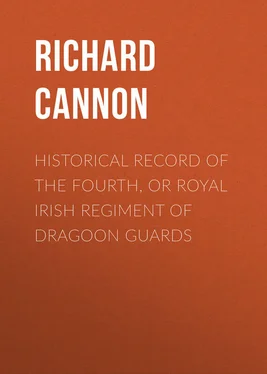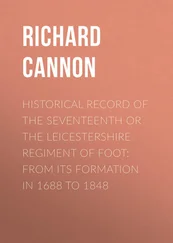Richard Cannon - Historical Record of the Fourth, or Royal Irish Regiment of Dragoon Guards
Здесь есть возможность читать онлайн «Richard Cannon - Historical Record of the Fourth, or Royal Irish Regiment of Dragoon Guards» — ознакомительный отрывок электронной книги совершенно бесплатно, а после прочтения отрывка купить полную версию. В некоторых случаях можно слушать аудио, скачать через торрент в формате fb2 и присутствует краткое содержание. Жанр: foreign_antique, foreign_prose, на английском языке. Описание произведения, (предисловие) а так же отзывы посетителей доступны на портале библиотеки ЛибКат.
- Название:Historical Record of the Fourth, or Royal Irish Regiment of Dragoon Guards
- Автор:
- Жанр:
- Год:неизвестен
- ISBN:нет данных
- Рейтинг книги:4 / 5. Голосов: 1
-
Избранное:Добавить в избранное
- Отзывы:
-
Ваша оценка:
- 80
- 1
- 2
- 3
- 4
- 5
Historical Record of the Fourth, or Royal Irish Regiment of Dragoon Guards: краткое содержание, описание и аннотация
Предлагаем к чтению аннотацию, описание, краткое содержание или предисловие (зависит от того, что написал сам автор книги «Historical Record of the Fourth, or Royal Irish Regiment of Dragoon Guards»). Если вы не нашли необходимую информацию о книге — напишите в комментариях, мы постараемся отыскать её.
Historical Record of the Fourth, or Royal Irish Regiment of Dragoon Guards — читать онлайн ознакомительный отрывок
Ниже представлен текст книги, разбитый по страницам. Система сохранения места последней прочитанной страницы, позволяет с удобством читать онлайн бесплатно книгу «Historical Record of the Fourth, or Royal Irish Regiment of Dragoon Guards», без необходимости каждый раз заново искать на чём Вы остановились. Поставьте закладку, и сможете в любой момент перейти на страницу, на которой закончили чтение.
Интервал:
Закладка:
Shortly after the battle of Steenkirk, the Princess Anne of Denmark's regiment of horse, 11 11 The Princess Anne's regiment was formed of independent troops of horse raised in June, 1685, and the Colonelcy conferred on the Earl of Scarsdale, who was succeeded, on the 1st of December, 1687, by Charles, Duke of St. Alban's. This regiment was remarkable for being one of the first corps which joined the Prince of Orange in November, 1688; having been conducted to His Highness's quarters by the Lieutenant-Colonel, Thomas Langston, who was immediately promoted to the Colonelcy of the regiment, and his brother, Captain Francis Langston, of the Royal Dragoons, was promoted to the Lieutenant-Colonelcy. Colonel Thomas Langston died of a fever at Lisburn, in Ireland, in December, 1689, and the Colonelcy of the regiment was conferred on his brother Francis. This regiment served at the battles of the Boyne and Aghrim in Ireland, and at Steenkirk in the Netherlands; but having lost many men and horses, the remainder were transferred to other corps, and the regiment was taken off the establishment of the army in the autumn of 1692. The officers served en seconde until vacancies occurred in other regiments.
which had lost many men and horses in the action, was disbanded; and on the 7th of March, 1693, its Colonel, Francis Langston, was appointed to the command of the Fifth Horse, vice Colonel Charles Godfrey, who retired.
In the ensuing campaign the regiment was again engaged for several weeks in marches, manœuvring, and occupying positions on the rich plains of the Netherlands, to defeat the designs of the enemy; and on the 19th of July it was engaged in the hard-contested battle of Landen , where it had an opportunity of distinguishing itself. It was formed, during the early part of the action, near the village of Neer-Landen, to support the infantry on the left, and sustained some loss from a heavy cannonade to which it was exposed. At length Marshal Luxembourg, by means of an immense superiority of numbers, carried the village of Neer-Winden, forced the position occupied by his opponents, and his numerous cavalry overpowered the squadrons in the right wing of the confederate army. King William instantly ordered the English horse on the left to oppose the victorious career of the enemy; and Langston's Regiment, galloping to the scene of conflict, charged the French horsemen with signal gallantry. The right squadron of this regiment, led by its Colonel, Francis Langston, broke the French squadron to which it was opposed, and made great slaughter; and the heroic Langston, an officer remarkable for prowess and valour, who had served against the Moors in Africa, and at the battles of the Boyne, Aghrim, and Steenkirk, was seen using his broadsword with terrible execution, but he was eventually surrounded, severely wounded, and taken prisoner. Fresh squadrons of French cavalry, flushed with the prospect of victory, renewed the fight, and, notwithstanding the bravery evinced by the English horse, superiority of numbers prevailed. King William ordered a retreat, which, having to be made across bridges and by narrow defiles, was not executed without much confusion and loss. His Majesty remained on the ground until nearly surrounded by the enemy; but he was rescued by a party of his Life Guards and a troop of Horse.
After retiring from the field, the regiment proceeded to Tirlemont; it was subsequently engaged in several movements, and on the 5th of August it was reviewed by King William, with the remainder of the cavalry, near Wemmel. In November it marched into quarters at Ghent.
Having been joined by a body of recruits and remount horses from England, to replace the losses of the preceding campaign, the regiment marched out of Ghent in May, 1694, to cantonments in the villages between Brussels and Dendermond. The campaign of this year was remarkable for the long and fatiguing marches performed by the troops; but no general engagement occurred. After traversing Flanders and Brabant in various directions, and experiencing much privation from the country having so long been the seat of war, the regiment returned to its former quarters.
The services of the regiment during the campaign of 1695 were limited to covering the siege of Namur , one of the strongest fortresses in Europe, and garrisoned by 15,000 men, commanded by a Marshal of France (Boufflers). When the siege was formed, the regiment was detached to graze the horses between Charleroi and Mons; it was subsequently engaged in manœuvring to protect the besieging forces from the attacks of the French army. In the beginning of August the regiment was encamped at Waterloo, and subsequently in the immediate vicinity of Namur. This fortress was eventually captured, and this event was considered the brightest feature in King William's military history, and one upon which he was often heard to declare his satisfaction.
After passing the winter in Ghent, the regiment was brigaded with the regiments of Lumley and Schomberg (now 1st and 7th Dragoon Guards), and was reviewed by the King on the 30th of May, 1696, "and made a very noble appearance." It served the campaign of this year under the Prince of Vaudemont in Flanders; and was encamped – first at Marykirk, and subsequently along the canal between Ghent and Bruges, to protect these places, with Nieuport, and the other maritime towns of Flanders, from the attacks of the enemy. A French army was encamped on the opposite side of the canal, and several skirmishes occurred, but no general engagement took place.
On the night of the 20th of September, Colonel Langston crossed the canal with a squadron of this regiment and a party of dragoons, and attacking one of the French outposts, defeated the guard and took thirty prisoners. The Prince of Vaudemont reviewed the regiment a few days after this event, and on the 5th of October it left the camp for winter-quarters in Ghent.
The regiment having been selected to form part of the army of Brabant during the campaign of 1697, it marched out of its winter-quarters in the early part of May, and pitched its tents at St. Quintin Linneck on the 16th of that month, and was formed in brigade with Leveson's, Windham's, and Galway's regiments (2nd and 6th Dragoon Guards, and a regiment of French Protestants.) It took part in several manœuvres, and during the night of the 12th of June it retired with the army through the forest of Soigne, and took post before Brussels, to protect that city from a siege. The regiment was subsequently encamped near Wavre, where it remained until peace was restored by the Treaty of Ryswick 12 12 When the regimental record was read to King William IV. in November, 1835, at the Royal Pavilion, Brighton, His Majesty observed – 'I was often at the house where the peace of Ryswick was signed. It was then the property of the Earl of Athlone, but now belongs to the Duchess of Saxe-Meiningen, sister to her Majesty the Queen.'
, which was signed in September. It afterwards marched to Ghent, and during the winter embarked for England.
After its return from foreign service the regiment was quartered at Northampton, Banbury, and Wellingborough; and, the House of Commons having voted that only 10,000 regular troops should be kept in pay in England, it was ordered, in February, 1698, to march to Highlake, in Cheshire, and to embark for Ireland.
Having landed at Dublin on the 31st of March, the regiment was placed on the Irish establishment, and the rates of pay of the non-commissioned officers and soldiers were reduced; the troops in Ireland being on a lower rate of pay than those in England.
The establishment of the regiment was fixed by a warrant under the sign-manual, bearing date the 1st of May, 1699, at the following numbers: —
Читать дальшеИнтервал:
Закладка:
Похожие книги на «Historical Record of the Fourth, or Royal Irish Regiment of Dragoon Guards»
Представляем Вашему вниманию похожие книги на «Historical Record of the Fourth, or Royal Irish Regiment of Dragoon Guards» списком для выбора. Мы отобрали схожую по названию и смыслу литературу в надежде предоставить читателям больше вариантов отыскать новые, интересные, ещё непрочитанные произведения.
Обсуждение, отзывы о книге «Historical Record of the Fourth, or Royal Irish Regiment of Dragoon Guards» и просто собственные мнения читателей. Оставьте ваши комментарии, напишите, что Вы думаете о произведении, его смысле или главных героях. Укажите что конкретно понравилось, а что нет, и почему Вы так считаете.












